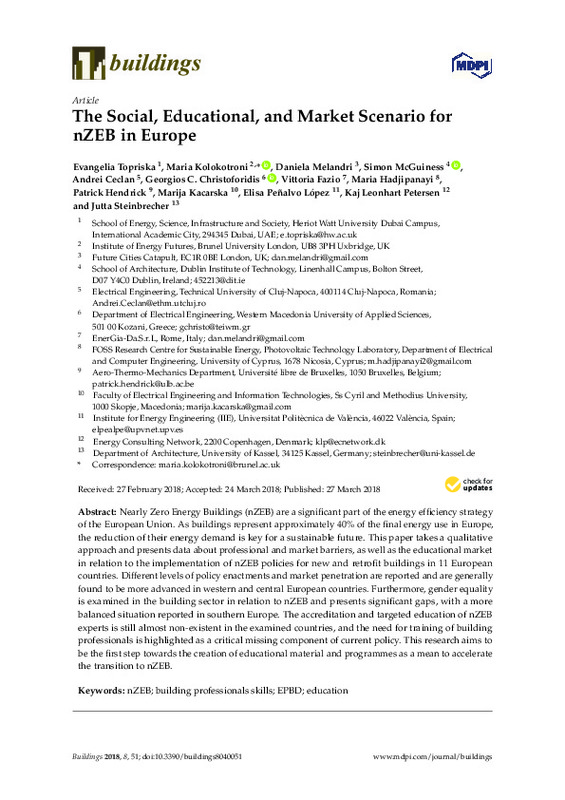Official Journal of the European Unionhttp://eur-lex.europa.eu/legal-content/EN/TXT/PDF/?uri=CELEX:32010L0031&from=EN
Nearly Zero Energy Buildings Definitions across Europehttp://bpie.eu/wp-content/uploads/2015/09/BPIE_factsheet_nZEB_definitions_across_Europe.pdf
Overview of Member States information on NZEBshttps://ec.europa.eu/energy/sites/ener/files/documents/Updated%20progress%20report%20NZEB.pdf
[+]
Official Journal of the European Unionhttp://eur-lex.europa.eu/legal-content/EN/TXT/PDF/?uri=CELEX:32010L0031&from=EN
Nearly Zero Energy Buildings Definitions across Europehttp://bpie.eu/wp-content/uploads/2015/09/BPIE_factsheet_nZEB_definitions_across_Europe.pdf
Overview of Member States information on NZEBshttps://ec.europa.eu/energy/sites/ener/files/documents/Updated%20progress%20report%20NZEB.pdf
Buildingshttps://ec.europa.eu/energy/en/topics/energy-efficiency/buildings
Directive 2012/27/EU of the European Parliament and of the Council of 25 October 2012 on Energy Efficiency, Amending Directives 2009/125/EC and 2010/30/EU and Repealing Directives 2004/8/EC and 2006/32/EChttp://eur-lex.europa.eu/legal-content/EN/TXT/PDF/?uri=CELEX:32012L0027&from=EN
Clean Energy for All Europeanshttps://ec.europa.eu/energy/en/topics/energy-strategy-and-energy-union/clean-energy-all-europeans
Pérez-Lombard, L., Ortiz, J., González, R., & Maestre, I. R. (2009). A review of benchmarking, rating and labelling concepts within the framework of building energy certification schemes. Energy and Buildings, 41(3), 272-278. doi:10.1016/j.enbuild.2008.10.004
Andaloro, A. P. F., Salomone, R., Ioppolo, G., & Andaloro, L. (2010). Energy certification of buildings: A comparative analysis of progress towards implementation in European countries. Energy Policy, 38(10), 5840-5866. doi:10.1016/j.enpol.2010.05.039
Casals, X. G. (2006). Analysis of building energy regulation and certification in Europe: Their role, limitations and differences. Energy and Buildings, 38(5), 381-392. doi:10.1016/j.enbuild.2005.05.004
Dascalaki, E. G., Balaras, C. A., Gaglia, A. G., Droutsa, K. G., & Kontoyiannidis, S. (2012). Energy performance of buildings—EPBD in Greece. Energy Policy, 45, 469-477. doi:10.1016/j.enpol.2012.02.058
Kampelis, N., Gobakis, K., Vagias, V., Kolokotsa, D., Standardi, L., Isidori, D., … Santamouris, M. (2017). Evaluation of the performance gap in industrial, residential & tertiary near-Zero energy buildings. Energy and Buildings, 148, 58-73. doi:10.1016/j.enbuild.2017.03.057
Ferrari, S., & Beccali, M. (2017). Energy-environmental and cost assessment of a set of strategies for retrofitting a public building toward nearly zero-energy building target. Sustainable Cities and Society, 32, 226-234. doi:10.1016/j.scs.2017.03.010
Harkouss, F., Fardoun, F., & Biwole, P. H. (2018). Multi-objective optimization methodology for net zero energy buildings. Journal of Building Engineering, 16, 57-71. doi:10.1016/j.jobe.2017.12.003
Giordano, R., Serra, V., Demaria, E., & Duzel, A. (2017). Embodied Energy Versus Operational Energy in a Nearly Zero Energy Building Case Study. Energy Procedia, 111, 367-376. doi:10.1016/j.egypro.2017.03.198
Sesana, M. M., & Salvalai, G. (2013). Overview on life cycle methodologies and economic feasibility for nZEBs. Building and Environment, 67, 211-216. doi:10.1016/j.buildenv.2013.05.022
Build Uphttp://www.buildup.eu/en
Meeting of Energy Proffesional Skillshttp://www.mens-nzeb.eu/en/
PROF TRAChttp://proftrac.eu/open-training-platform-for-nzeb-professionals.html
Nearly Zero-Energy Building Strategy 2020http://zebra2020.eu/
GeoCluster Mapping Toolhttp://www.geoclusters.eu/ge2O/#
Sesana, M. M., Cuca, B., Iannaccone, G., Brumana, R., Caccavelli, D., & Gay, C. (2015). Geomapping methodology for the GeoCluster Mapping Tool to assess deployment potential of technologies for energy efficiency in buildings. Sustainable Cities and Society, 17, 22-34. doi:10.1016/j.scs.2015.02.006
Commission Recommendation (EU) 2016/1318https://publications.europa.eu/en/publication-detail/-/publication/f2a71495-5876-11e6-89bd-01aa75ed71a1/language-en
Danish Energy Agencyhttps://ens.dk/en
Towards Nearly Zero Energy Buildings in Ireland—Planning for 2020 and Beyondhttp://nzeb-opendoors.ie/sites/www.nzeb-opendoors.ie/files/page-files/Towards%20NZEBs%20in%20Ireland_Nov%202012.pdf
Serghides, D. K., Michaelidou, M., Christofi, M., Dimitriou, S., & Katafygiotou, M. (2017). Energy Refurbishment Towards Nearly Zero Energy Multi-family Houses, for Cyprus. Procedia Environmental Sciences, 38, 11-19. doi:10.1016/j.proenv.2017.03.068
National Integrating Reporthttp://www.mens-nzeb.eu/en/information/expocenter/publications/?page=2
Boyd, P., & Schweber, L. (2017). Unintended consequences: institutional artefacts, closure mechanisms and the performance gap. Building Research & Information, 46(1), 10-22. doi:10.1080/09613218.2017.1331096
Paduos, S., & Corrado, V. (2017). Cost-optimal approach to transform the public buildings into nZEBs: an European cross-country comparison. Energy Procedia, 140, 314-324. doi:10.1016/j.egypro.2017.11.145
D’Agostino, D., & Parker, D. (2018). A framework for the cost-optimal design of nearly zero energy buildings (NZEBs) in representative climates across Europe. Energy, 149, 814-829. doi:10.1016/j.energy.2018.02.020
Santamouris, M., Paravantis, J. A., Founda, D., Kolokotsa, D., Michalakakou, P., Papadopoulos, A. M., … Servou, E. (2013). Financial crisis and energy consumption: A household survey in Greece. Energy and Buildings, 65, 477-487. doi:10.1016/j.enbuild.2013.06.024
Santamouris, M., Alevizos, S. M., Aslanoglou, L., Mantzios, D., Milonas, P., Sarelli, I., … Paravantis, J. A. (2014). Freezing the poor—Indoor environmental quality in low and very low income households during the winter period in Athens. Energy and Buildings, 70, 61-70. doi:10.1016/j.enbuild.2013.11.074
CRESME, Ristrutturazione edilizia, riqualificazione energetica, rigenerazione urbanahttp://www.old.awn.it/AWN/Engine/RAServeFile.php/f/RAPPORTO_riuso03.pdf
Analysis of Current Situation in Cyprus—Build-up Skills Projectwww.buildupskills.eu
The Architectural Profession in Europe 2014http://www.ace-cae.eu/fileadmin/New_Upload/7._Publications/Sector_Study/2014/EN/2014_EN_FULL.pdf
National Institute of Statisticshttp://www.insse.ro/cms/ro/content/lucrarile-de-constructii
Hauptverband der deutschen Bauindustrie e.V, Entwicklung der Bauinvestitionenhttp://www.bauindustrie.de/zahlen-fakten/bauwirtschaft-im-zahlenbild/
Bijna-energieneutraal (BEN)http://www.energiesparen.be/BEN
Technical Chamber of Greeceteeserver.tee.gr/online/afieromata/2000/2091/index.shtml
Registry of Certified Energy Auditors in Greecehttps://www.buildingcert.gr/inspectors/startValues.view
80% Real Unemployment in Engineershttp://www.larissanet.gr/2014/10/20/sto-80-i-pragmatiki-anergia-stous-michanikous
University and Researchhttp://www.chistera.eu/miur
Education at a Glancehttp://www.oecd.org/edu/Italy-EAG2014-Country-Note.pdf
Gli ingegneri nel mercato del lavorohttp://cache.b.centrostudicni.it/images/pubblicazioni/ricerche/Gli_ingegneri_nel_mercato_del_lavoro_finale_d2646.pdf
El Colegio de Ingenieros Industriales presenta un plan para reducir el paro juvenil a la mitadhttp://www.lasprovincias.es/economia/trabajo/201502/16/colegio-ingenieros-industriales-presenta-20150216130712.html
La empleabilidad de los Ingenieros Industriales en Españahttp://www.revistadyna.com/busqueda/la-empleabilidad-de-ingenieros-industriales-espanoles
The current situation of gender equality in Cyprus—Country Profilehttp://ec.europa.eu/justice/gender-equality/files/epo_campaign/131128_country_profile_cyprus.pdf
Eurostat Labour Force Surveyhttp://ec.europa.eu/eurostat/statistics-explained/index.php/Labour_market_and_Labour_force_survey_(LFS)_statistics
European Engineering Reporthttps://www.vdi.de/uploads/media/2010-04_IW_European_Engineering_Report_02.pdf
A Higher Degree of Concernhttps://royalsociety.org/~/media/Royal_Society_Content/policy/publications/2008/7966.pdf
Number of Women in Engineering Increasinghttp://www.engineersireland.ie/Communications/Press-Archive/Number-of-Women-in-Engineering-Increasing.aspx
Architectural Practices Employment Survey by Millward Brown IMS Commissioned in 2009 by RIAIhttp://www.riai.ie/news/article/41_of_architects_will_have_lost_their_jobs_by_march_2009
National Skills Bulletin 2015http://www.skillsireland.ie/Publications/2015/National%20Skills%20Bulletin%202015.html
Technical University of Cluj Napoca, Report on 2014www.utcluj.ro/media/documents/2015/Raport_Rector_2014_1.pdf
Bundesarchitektenkammer e.V, Bundeskammerstatistik nach Geschlechternhttp://www.bak.de/architekten/wirtschaft-arbeitsmarkt/architektenbefragungen/bundeskammerstatistik
Bundesingenieurkammer e.V, Geschlechterstruktur in Ingenieurberufen (2011)https://bingk.de/ingenieurstatistik/
Ingenieurstatistik, Erwerbstätige und Arbeitslose in Ingenieurberufen 2007–2010http://bingk.de/wp-content/uploads/2015/02/Bundesingenieurkammer_Arbeitslosenstatistik_1._Stand_Dezember_2011-1.pdf
Ingenieurstatistik, Entwicklung der Arbeitslosigkeit bei Ingenieuren und Architektenhttp://bingk.de/ingenieurstatistik
Ingeniørobservatoriethttp://ida.dk/sites/default/files/Ingeni%c3%b8robservatoriet%202011%20ENDELIGT.pdf
Bedrijven hebben laag aantal vrouwelijke ingenieurs aan zichzelf te dankenhttps://www.tijd.be/opinie/analyse/Bedrijven-hebben-laag-aantal-vrouwelijke-ingenieurs-aan-zichzelf-te-danken/9318972
Accueilhttp://www.fabi.be/
Ingenieur is het meest aantrekkelijke beroep in Belgiëhttp://www.mainpress.com/nederlands/dossier_pompen/pdf/randstad.pdf
Selected examples of Nearly Zero Energy Buildings—Detailed Reporthttps://www.epbd-ca.eu/wp-content/uploads/2011/05/CT5_Report_Selected_examples_of_NZEBs-final.pdf
Practiceshttp://www.buildup.eu/en/practices/cases
Intelligent Energy Europehttp://www.buildup.eu/en
Learning Opportunities and Qualifications in Europehttps://ec.europa.eu/ploteus/search/site?f%5B0%5D=im_field_entity_type%3A97
[-]









